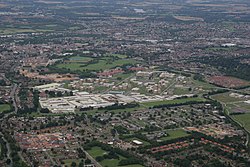Napoleonic Wars (1792–1815)
Colchester Garrison played an eminent role during the Napoleonic Wars. The troops were originally billeted in local inns and houses. After petitioning from the borough council, new infantry barracks were built in 1794. By 1800 additional infantry, artillery, and cavalry barracks had been built in the area bounded by Barrack Street to the north, Wimpole Road to the west, and Port Lane to the east. In 1805 the barracks were home to 7,000 officers and men. After the Napoleonic Wars the barracks were reduced. The sale of the older barracks and the freehold site on which they stood started in 1817 and was completed in 1840. The Army retained 14 acres (57,000 m2) and an infantry barracks for 851 officers and men. Much of the old barracks land was developed as the "New Town" area of Colchester during the Victorian era. [1] The south wing of the Military Hospital was purchased by Rev Jefferson and seven other subscribers and rebuilt on a plot of land on Lexden Road as the Essex and County Hospital. [2]
Crimean War (1854–1856)
Colchester Garrison experienced rapid expansion during the Crimean War. Between 1855 and 1856 wooden infantry barracks for 5,000 troops were erected on Ordnance Field. The government purchased 167-acre (0.68 km2) Middlewick Farm for use as a training area and a rifle range in 1857. Middlewick Ranges were still in use by the garrison until the land was sold in 2024. [3]
British German Legion
In 1856 10,000 troops of the British German Legion were billeted in the infantry barracks and in tented encampments on Barrack Field. [1] The British German Legion was raised in 1854 as a foreign corps in British service (similar to the Kings German Legion during the Napoleonic Wars). The Legion was raised for service in the Crimean War, under the provisions of the Enlistment of Foreigners Act 1854. [4] The Legion did not see active service although a large number of legionaries went to the Crimea where they mostly died of fever without seeing the battlefields. The Legion was disbanded in Colchester in 1857, but the majority of the remaining personnel went to the Eastern Cape as part of the Kaffraria Settlement. Because preference was given to those who were married or had a fiancée, men without German wives or fiancees married, in great numbers, Colchester girls. There are dozens of marriages recorded in the Colchester Churches, mainly St Botolph's, and the remainder were married at the Garrison Church. This establishment was later found not to be registered for marriages, and so the affected couples were declared wed by Act of the Cape Parliament in 1858. [5]
Second World War (1939–1945)
Home Guard
During the war the town was defended by local defence volunteers of 8th Essex Battalion of the Home Guard. At the height of its strength, the battalion mustered over 2,000 men. The battalion possessed no fewer than 22 different types of weapon, including Vickers machine guns, flame throwers, and 2 pounder anti tank guns. Additional support throughout the area was provided by 13th Essex Battalion, made up of volunteers from the GPO who were charged with the protection of critical telecommunications infrastructure. [13]
The order to "stand down" for the Home Guard came on 1 November 1944. They took their final salute on 19 November before the Lord Lieutenant of the county, Colonel Sir Francis Whitmore. Whitmore said, "You have, by your sense of duty, your loyalty and patriotism, contributed pages of tradition to the historical records of our nation... you took a prominent part in the defence of our country at the most critical period of the war... In the name of the County of Essex, I thank you." [14]
Colchester Stop Line
During the war the town was ringed by over 120 pillboxes or other defensive structures as part of the Colchester Stop Line. A small number of pillboxes can still be found around the borough, such as at Mount Bures, [15] and the Hythe railway station. [16]
Colchester Blitz
Air raid sirens sounded over 1000 times in Colchester during the course of the war. Colchester was attacked by the Luftwaffe on several occasions. [17] They included:
- Severalls Raid – On 11 August 1942 38 people were killed when a German plane dropped a stick of bombs on Severalls Hospital.
- Chapel Street Raid – 8 people were killed when a Dornier 217 dropped four bombs on South Street and Essex Street on 28 September 1942. The air raid siren, in this case, only sounded after the bombs had already dropped, causing outcry in the town.
- St Botolphs Raid – In February 1944 a large Luftwaffe firebombing raid dropped a stream of 1,400 incendiary bombs on the St Botolphs area of the town, destroying 14 buildings and seriously damaging 99 others. Two-thirds of the Paxman Britannia Works was destroyed during the raid.
Home Guard anti-aircraft batteries were established on Abbey Field and engaged enemy aircraft 14 times during a 21-month period.
Americans in Colchester
The first American military personnel arrived in Britain in January 1942. A significant American presence was established in the Colchester area, with many air bases of the US Eighth Air Force located in the district – at Earls Colne, Langham, Wormingford, Messing, and Dedham. In accordance with racial segregation of the American military during World War II, the American Red Cross established several social clubs in the area. [18]





